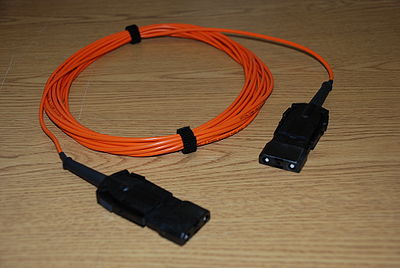
ESCON
Encyclopedia

IBM
International Business Machines Corporation or IBM is an American multinational technology and consulting corporation headquartered in Armonk, New York, United States. IBM manufactures and sells computer hardware and software, and it offers infrastructure, hosting and consulting services in areas...
, and is commonly used to connect their mainframe computer
Mainframe computer
Mainframes are powerful computers used primarily by corporate and governmental organizations for critical applications, bulk data processing such as census, industry and consumer statistics, enterprise resource planning, and financial transaction processing.The term originally referred to the...
s to peripheral devices such as disk storage
Disk storage
Disk storage or disc storage is a general category of storage mechanisms, in which data are digitally recorded by various electronic, magnetic, optical, or mechanical methods on a surface layer deposited of one or more planar, round and rotating disks...
and tape drive
Tape drive
A tape drive is a data storage device that reads and performs digital recording, writes data on a magnetic tape. Magnetic tape data storage is typically used for offline, archival data storage. Tape media generally has a favorable unit cost and long archival stability.A tape drive provides...
s. ESCON is an optical fiber
Optical fiber
An optical fiber is a flexible, transparent fiber made of a pure glass not much wider than a human hair. It functions as a waveguide, or "light pipe", to transmit light between the two ends of the fiber. The field of applied science and engineering concerned with the design and application of...
, half-duplex, serial
Serial communications
In telecommunication and computer science, serial communication is the process of sending data one bit at a time, sequentially, over a communication channel or computer bus. This is in contrast to parallel communication, where several bits are sent as a whole, on a link with several parallel channels...
interface. It originally operated at a rate of 10 Mbyte/s, which was later increased to 17Mbyte/s. The current maximum distance is 43 kilometers.
ESCON was introduced by IBM in the early 1990s. It replaced the older, slower (4.5 Mbyte/s), copper-based, parallel, Bus & Tag channel technology of 1960-1990 era mainframes. Optical fiber is smaller in diameter and weight, and hence could save installation costs. Space and labor could also be reduced when fewer physical links were required - due to ESCON's switching features. ESCON is being supplanted by the substantially faster FICON
FICON
FICON is the IBM proprietary name for the ANSI FC-SB-3 Single-Byte Command Code Sets-3 Mapping Protocol for Fibre Channel protocol. It is a FC layer 4 protocol used to map both IBM’s antecedent channel-to-control-unit cabling infrastructure and protocol onto standard FC services and infrastructure...
, which runs over Fibre Channel
Fibre Channel
Fibre Channel, or FC, is a gigabit-speed network technology primarily used for storage networking. Fibre Channel is standardized in the T11 Technical Committee of the InterNational Committee for Information Technology Standards , an American National Standards Institute –accredited standards...
.
ESCON allows the establishment and reconfiguration of channel connections dynamically, without having to take equipment off-line and manually move the cables. ESCON supports channel connections using serial transmission over a pair of fibers. The ESCON Director supports dynamic switching (which could be achieved prior to ESCON, but not with IBM-only products). It also allows the distance between units to be extended up to 60 km over a dedicated fiber. “Permanent virtual circuits” are supported through the switch.
ESCON switching has advantages over a collection of point-to-point links. A peripheral previously capable of accessing a single mainframe can now be connected simultaneously to up to eight mainframes, providing peripheral sharing.
The ESCON interface specifications were adopted in 1996 by ANSI
American National Standards Institute
The American National Standards Institute is a private non-profit organization that oversees the development of voluntary consensus standards for products, services, processes, systems, and personnel in the United States. The organization also coordinates U.S. standards with international...
X3T1 committee as the SBCON standard, which is now managed by X3T11
Fibre Channel
Fibre Channel, or FC, is a gigabit-speed network technology primarily used for storage networking. Fibre Channel is standardized in the T11 Technical Committee of the InterNational Committee for Information Technology Standards , an American National Standards Institute –accredited standards...
.
See also
- Direct access storage deviceDirect access storage deviceIn mainframe computers and some minicomputers, a direct access storage device, or DASD , is any secondary storage device which has relatively low access time relative to its capacity....
(DASD) - Most important DASD (disk arrays) with ESCON interfaces:
- IBM ESSIBM Enterprise Storage ServerThe IBM Enterprise Storage Server or the Shark is an enterprise storage array from IBM.-History:Originally, in 1998 IBM released the IBM 2105 Versatile Storage Server...
2105 (Shark) - IBM System StorageIBM System StorageIBM System Storage is the brand name for IBM's computer storage products, covering both Disk and Tape products.-DS3000 Series:The DS3000 products are made for IBM by LSI* DS3200...
DS8000 - HitachiHitachi, Ltd.is a Japanese multinational conglomerate headquartered in Marunouchi 1-chome, Chiyoda, Tokyo, Japan. The company is the parent of the Hitachi Group as part of the larger DKB Group companies...
Lightning - EMC Symmetrix
- HP XPHP XPThe HP Storageworks XP is an enterprise storage disk array sold by Hewlett-Packard using Hitachi hardware and adding their own software to it. It is similar to the Hitachi Lightning and Sun StorEdge 9900 and targeted towards enabling large scale consolidation, large database, Oracle, SAP,...
- Sun StorageTek SVA
- IBM ESS

